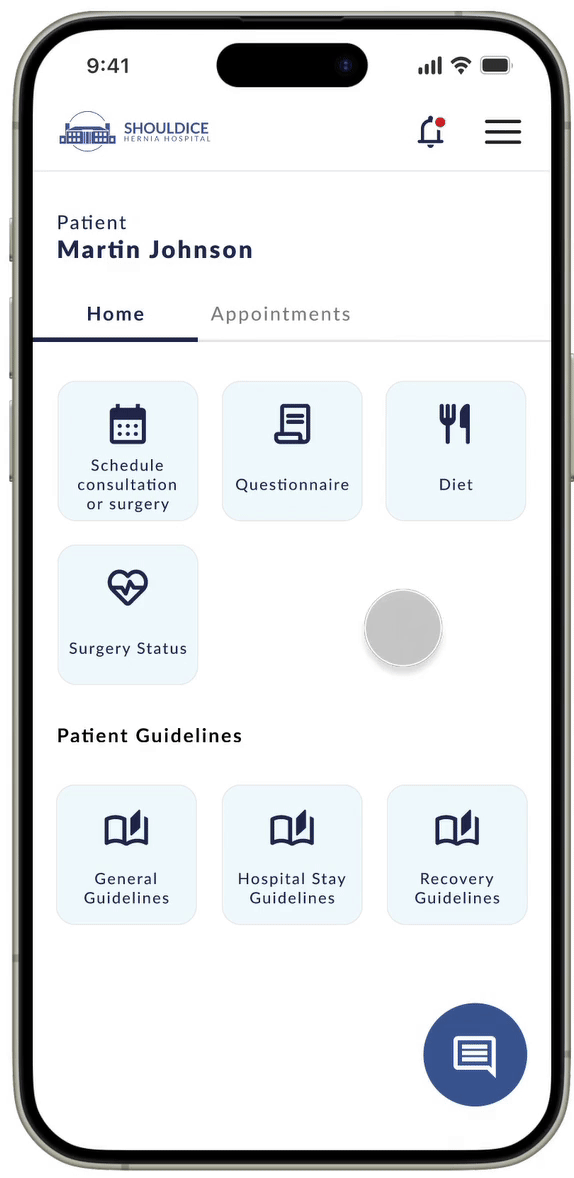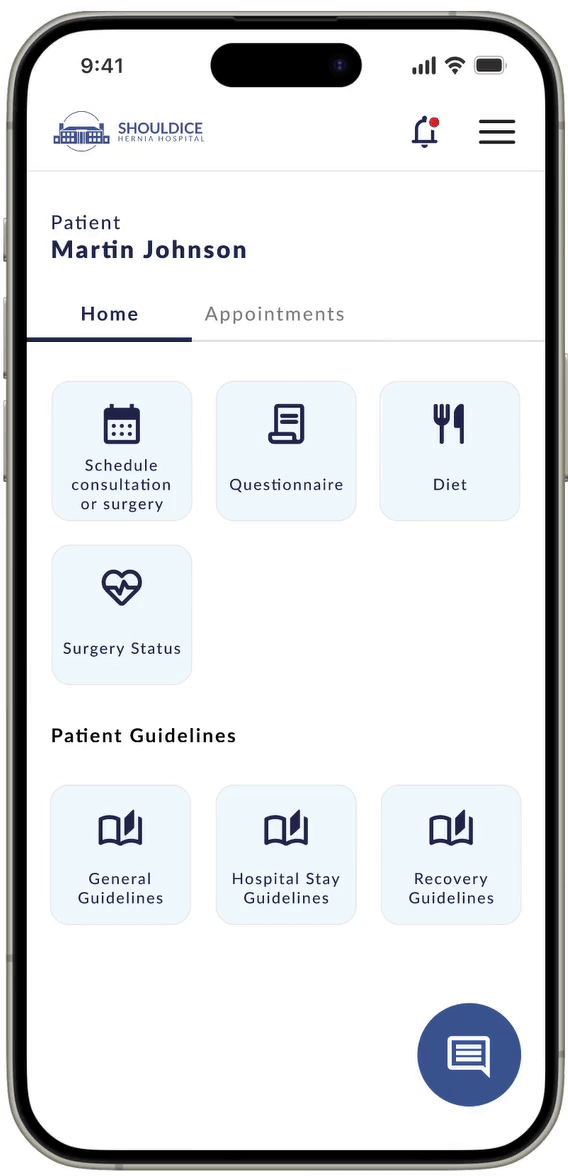top of page


2024
Service Design Project for Shouldice Hospital
Overview
Shouldice Hospital is the global leader in Hernia Surgery, located in Ontario (Canada). It treats domestic and international patients. Its focus is on providing the best experience, but over the years, the hospital has become outdated and has significantly increased its waiting time.
The team and I investigated the problem through site audits and user interviews to understand the whole process and provide suggestions for improvements that would benefit patients and the hospital’s long-term stability and continued success.
Sector
Healthcare
Role
Service Designer, UX/UI Designer & Team coordinator
Methods
Site audit, Service Design, Interviews, Blueprint, Persona, Journey map, Bodystorming, Workshop, Prototyping
Team
4 UX Designers
Problem
We uncovered two main problems:
1. Outdated & inefficient communication systems (front stage/ backstage, pre-surgery and during surgery) to connect with patients.
2. Long wait times for surgery and consultations (8+ months total) due to lack of surgeons.
Goal
-
Assure the long-term stability of the hospital as a global leader in hernia treatment
-
Shorten the wait time & increase the number of surgeries
-
Improve the patient and companion satisfaction while managing their expectations and anxiety
Outcome
We created two groups of solutions organized by time and effort:
1. The short- and mid-term solutions are to digitalize the hospital, create a patient portal, update the website, create brochures, and create other graphic solutions.
2. The long-term solution is to increase the appealing of the hospital, explore diverse recruitment strategies & offer better financial benefits to hire more doctors.



The process
About Shouldice Hospital
Founded in 1945, Shouldice Hospital is a private hospital specialized in inguinal hernia repair using no-mesh repair surgery. Its treatment technique achieves 99% of success rate and is worldwide recognized by that.
Surgeries per day: 30
Number of recovery beds: 89
Persona: Mostly man, 45yo+
Service: 4-day stay for hernia treatment
Primary Research: Site Audit & Interviews
To gain a deeper understanding of the processes and pain points, we conducted a site audit alongside in-depth interviews with the business manager and various employees. Additionally, we interviewed patients to uncover key opportunities in their journey. These insights informed the creation of a detailed service blueprint, allowing us to map out the entire process and identify critical areas for improvement.







Opportunity Areas
With this information at hand, we identified two main opportunities areas to explore:
Communication with patients
-
Outdated & inefficient communication systems (frontstage/ backstage, pre-surgery and during surgery) to connect with patients
-
Lack of key information about the surgery process, schedules & drugs
Shortage of surgeons
-
Wait times for surgery are 6 months on average, due to the lack of surgeons
-
Their surgery technique is so exclusive that the fresh surgeons need to be trained for 6 months before onboarding

Ideation
We facilitated a co-creation workshop, actively engaging users in a brainstorming session using the "How might we..." approach to uncover hidden solutions. These ideas were then tested through a bodystorming session, focusing on improving communication efficiency and transparency between patients and their companions.
We focused on simulating Day 1 of hospital admission, a key moment filled with numerous touchpoints, to explore and refine our solutions in a realistic setting.
Bodystorming
Co-creation workshop



Service Blueprint
The validated ideas were then compiled into a TO-BE service blueprint, highlighting the proposed improvements in patient and companion communication, as well as streamlining the overall admission process.

Solutions
We created solutions for both main problems:
Communication with patients
1. Rebranding
2. Brochures
3. Display System
4. Updated Website
5. Patient portal
Wait time
1. Enhance hospital appeal with technology
2. Create a sense of belonging for new doctors
3. Diversify the hiring process
4. Financial benefits
Communication with patients
Our suggestions consist in creating more ways of communication with the patients, such as physical/digital prochures, display system to keep track of patient status, and a redesign of the website for a clearer communication.



The patient portal
A patient portal is an essential tool that centralizes all medical information, including appointments, treatment guidelines, and dietary prescriptions, in one convenient place. Accessible via the hospital's website with a secure login, patients can easily manage their healthcare from any device, whether a laptop or smartphone.
The portal enables users to track appointments, follow treatment plans, and stay on top of dietary recommendations, promoting active involvement in their care. By streamlining communication and providing easy access to critical information, the portal contributes to improved health outcomes.


Manage appointments
You can manage all appointments directly on the portal and check the upcoming and completed ones.
Surgery Status
Patient companion can access the surgery status on their phone, managing axiety.


Access Guidelines
The patient can access the guidelines of all the process stages: pre-operation, during the stay, and recovery.
Notifications & Chat
The patient gets notifications on their profile and can access the online chat with the hospital.

Wait time
Lack of new doctors
We aim to explore a variety of recruitment strategies to increase the number of permanent doctors at the hospital. This will help ensure the hospital's long-term stability and ongoing success.
1. Enhancing hospital appeal with technology: Digitalize the system and charts. Review the doctors facilities if they also need to be updated.
2. Promote a sense of belonging for new doctors: Introducing new doctors to a long-standing staff can be challenging. We recommend creating mentorship, team integration, and open communication to help them feel valued and quickly integrated.
3. Diversify the hiring process: Actively hunt with specialized agencies, talk with recent graduate students, and develop a partnership with school hospitals.
4. Financial Benefits: Enhance financial benefits to make the position more attractive and compelling.
Success Measurement Plan
Communication with patients
-
Implement Customer Satisfaction Score pre-op, during stay, and post-op
-
Minimize the number of calls for questions and confirmations by 20%
Wait time
-
Time from the first consultation to the surgery date
-
Ratio doctors per patient

Thanks for reading!
bottom of page
